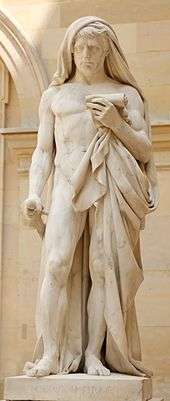Jean-Baptiste Roman
Jean-Baptiste Roman (31 October 1792 – 13 February 1835) was a French sculptor. He was born and died in Paris. Among his works is a sculpture on the death of Cato the Younger, a theme that became popular along with revolutionary sentiment.[1] It depicts Cato reading the Phaedo of Plato, on the death of Socrates, heroically nude as he contemplates his own death. The piece was commissioned in 1832 for the Louvre, but was finished by François Rude after his friend's death.

Jean-Baptiste Roman's Cato of Utica Reading the Phaedo before Committing Himself to Death (1832)
Roman was an instructor in sculpture at the École des beaux-arts; his vacant place was filled in 1835, by Louis-Messidor Lebon Petitot, full professeur from 1845 to 1862.[2]
List of works
- L'Innocence (1822), a nude girl holding a lizard, an emblem of innocence.
- Le peintre Girodet (1827), a portrait bust of Anne-Louis Girodet de Roussy-Trioson (1767–1824)
- Nisus et Euryale (1827)
- Caton d'Utique lisant le Phédon avant de se donner la mort (1832) with François Rude
gollark: No. This is wrong.
gollark: No. Lua patterns are less powerful than regex. Regex cannot parse HTML.
gollark: Probably.
gollark: You're not compiling it into anything.
gollark: https://www.w3.org/TR/2011/WD-html5-20110113/parsing.htmlIt's quite large.
References
Information not otherwise noted comes from the Atlas database of the Louvre.
- "Cato the Younger," in The Classical Tradition (Harvard University Press, 2010), p. 181.
- Procès-verbaux de l'Académie des Beaux-arts: 1830-1834, edited by Jean-Michel Leniaud (Paris, 2004), vol. 5, p. 183.
| Wikimedia Commons has media related to Jean-Baptiste Roman. |
This article is issued from Wikipedia. The text is licensed under Creative Commons - Attribution - Sharealike. Additional terms may apply for the media files.